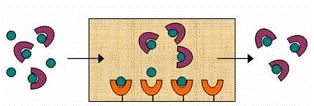Chemistry, Department of: Faculty Series

David Hage Publications
Document Type
Article
Date of this Version
5-2009
Citation
Published in final edited form as: J Sep Sci.2009 May ; 32(10): 1507–1522. doi:10.1002/jssc.200800685. Version presented here is from NIH PubMed Central.
Abstract
The rates at which biological interactions occur can provide important information on the mechanism and behavior of such processes in living systems. This review will discuss how affinity chromatography can be used as a tool to examine the kinetics of biological interactions. This approach, referred to here as biointeraction chromatography, uses a column with an immobilized binding agent to examine the association or dissociation of this agent with other compounds. The use of HPLC-based affinity columns in kinetic studies has received particular attention in recent years. Advantages of using HPLC with affinity chromatography for this purpose include the ability to reuse the same ligand within a column for a large number of experiments, and the good precision and accuracy of this approach. A number of techniques are available for kinetic studies through the use of affinity columns and biointeraction chromatography. These approaches include plate height measurements, peak profiling, peak fitting, split-peak measurements, and peak decay analysis. The general principles for each of these methods are discussed in this review and some recent applications of these techniques are presented. The advantages and potential limitations of each approach are also considered.


Comments
Copyright John Wiley & Sons. Used by permission.